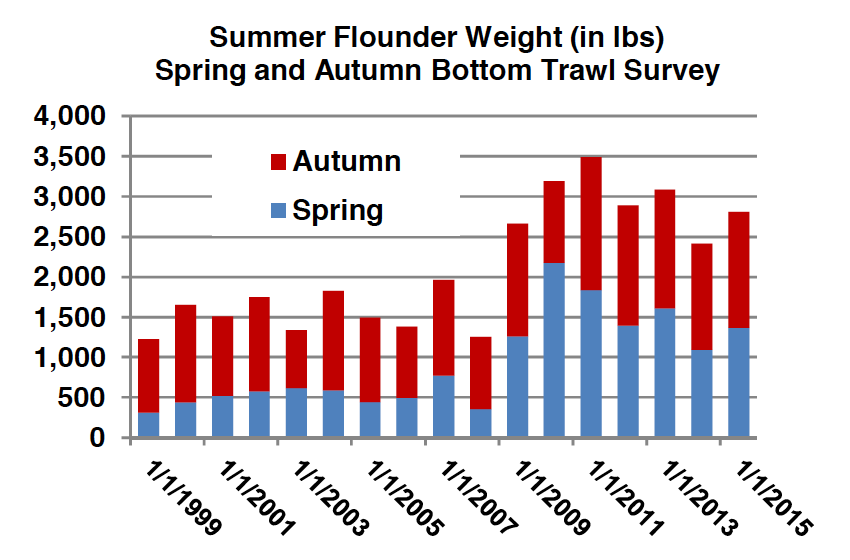October 20, 2016 — Summer flounder, also known as fluke, support recreational and commercial fisheries that are among the most important in the mid-Atlantic and southern New England. They have been a mainstay of recreational fishermen either from their own boats or on for-hire vessels, support a large directed commercial fishery, their incidental harvest is important in other fisheries and they are near the top of the list of must-have meals for summer visits to the shore. Hundreds of party and charter boats depend on them for all or for part of their annual incomes, thousands of private boats seek them out every summer, and much of the business bait and tackle shops do every year depends on the fishery. Hundreds of commercial fishing boats target them or take them incidentally in other fisheries.
 To say that the summer flounder fishery is important to tens of thousands of people from Cape Cod to Cape Hatteras would be an understatement. The fishery is more important to both recreational and commercial fishermen than any other in the Mid-Atlantic and southern New England.
To say that the summer flounder fishery is important to tens of thousands of people from Cape Cod to Cape Hatteras would be an understatement. The fishery is more important to both recreational and commercial fishermen than any other in the Mid-Atlantic and southern New England.
“By 2010 the fishing mortality on summer flounder had declined to its lowest level in at least 30 years, and summer flounder stock biomass was the highest since the stock assessments began in the 1960s” (from The summer flounder chronicles II: new science, new controversy, 2001–2010, M. Terciero, Reviews in Fish Biology and Fisheries, Dec 2011).
But in a memo dated 25 July 2016, the Chair of the Mid-Atlantic Fishery Management Council’s Scientific and Statistical Committee (SSC), wrote “the revised understanding of the stock status produced by the assessment update indicates reductions in the estimates of SSB, and increases in the estimates of annual Fs.” So 5 years after declaring that the summer flounder stock was at its highest level in half a century the managers decided fishing mortality was greater that it had been thought to be and that there were fewer summer flounder than was previously estimated.
Following a quota cut for both recreational and commercial fishermen of 27% for the 2016 fishing year it was decided that a 31% cut was necessary in 2017. That’s a 50% reduction in landings in two years.
The NOAA Northeast Fisheries Science Center in Woods Hole, MA conducts annual bottom trawl surveys in the spring and the fall that have been continuous since 1963. They are designed to give a relative measure of the abundance of the various species caught. The chart on the right shows that there has been nothing particularly dramatic going on with the summer flounder in either the spring or autumn survey, seemingly nothing that would warrant such draconian quota cuts (note that beginning in 2009 a new survey vessel was employed, resulting in higher absolute catches).
 With the quota reduction in 2017, commercial summer flounder landings are going to be at their lowest point since 1974. From 1950 to 2014 annual commercial landings averaged 7,200 metric tons. The 2017 quota will be one third of that. In the words of the head of NMFS in 2011 ”in 1976, federal management of marine fisheries was virtually non-existent. With the exception of state managed waters, federal activities were limited to supporting a patchwork of fishery specific treaties governing international waters, which at that time existed only 12 miles off our nation’s coasts.” In twenty-three of the twenty-six years between 1950 and 1976, pre-Magnuson years with no significant management of summer flounder, commercial landings were higher than they will be in 2017, which will be the fortieth year of intensive management of the fishery. This management has involved annual surveys, at least 100 meetings (usually involving at least a dozen people and usually held at coastal resorts or conference centers) and over 8,000 pages (either dealing with summer flounder alone or in combination with sea bass and scup, which are all included in the same management plan) of reports, calculations, charts and tables, memos, meeting notices and on and on.
With the quota reduction in 2017, commercial summer flounder landings are going to be at their lowest point since 1974. From 1950 to 2014 annual commercial landings averaged 7,200 metric tons. The 2017 quota will be one third of that. In the words of the head of NMFS in 2011 ”in 1976, federal management of marine fisheries was virtually non-existent. With the exception of state managed waters, federal activities were limited to supporting a patchwork of fishery specific treaties governing international waters, which at that time existed only 12 miles off our nation’s coasts.” In twenty-three of the twenty-six years between 1950 and 1976, pre-Magnuson years with no significant management of summer flounder, commercial landings were higher than they will be in 2017, which will be the fortieth year of intensive management of the fishery. This management has involved annual surveys, at least 100 meetings (usually involving at least a dozen people and usually held at coastal resorts or conference centers) and over 8,000 pages (either dealing with summer flounder alone or in combination with sea bass and scup, which are all included in the same management plan) of reports, calculations, charts and tables, memos, meeting notices and on and on.
Kind of makes you wonder what’s going on with summer flounder management, doesn’t it?
